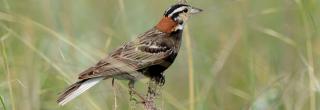
Best Management Practices and Management Plans
The following is a list of best practices and plans produced by the Department.
Wind Energy Development in North Dakota: Best Management Practices (2021)
The Best Management Practices were developed to provide recommendations for addressing wildlife and habitat concerns at all stages of wind energy development. The objective of this document is to assist developers in minimizing direct and indirect impacts to key fish and wildlife species and habitat while maximizing wind energy benefits.
Recommended Management Practices for Reducing Oil/Gas Impacts to Wildlife (last updated 3/1/2013)
This document is a compilation of recommendations developed by the North Dakota Petroleum Council and the North Dakota Game and Fish Department for use in reducing oil/gas exploration and production impacts to fish and wildlife resources in North Dakota.
Potential Impacts of Oil and Gas Development on Select ND Natural Resources (May 2011)
Recognizing unprecedented growth in the state’s energy industry will make our mission increasingly challenging, the ND Game and Fish Director formed an internal energy task force in February 2010. This report expands upon an initial task force document by providing a technical look at species specific impacts and potential mechanisms for mitigation. General recommendations for reducing impacts are provided in Appendix A.
North Dakota State Wildlife Action Plan (2015)
The State Wildlife Action Plan is the principal document for safeguarding rare and declining fish and wildlife species in North Dakota. North Dakota’s SWAP is intended to identify species of greatest conservation priority, provide fundamental background information, strategic guidance, input from partners, and most importantly, a framework for developing and coordinating conservation actions to safeguard all fish and wildlife resources.
Management Plan and Conservation Strategies for Greater Sage-Grouse in North Dakota (2014)
The goal of this plan is to provide for long-term conservation and enhancement of big sagebrush steppe/mixed-grass prairie habitats in North Dakota in a manner that will support a self-sustaining sage-grouse population, a diversity and abundance of other wildlife species, and human uses. Conservation objectives and strategies are outlined in section IV of the plan.
North Dakota Bighorn Sheep Management Plan 2013-2023 (November 2013)
This plan outlines the history and biology of bighorn sheep, population management, harvest strategy, health monitoring, issues and strategies for bighorn sheep in North Dakota.
North Dakota State Bat Management Plan (2015)
This plan provides basic information on the natural history of bats, outlines the major threats to bats in the Great Plains, and provides managers and researchers with tools for studying the bats of North Dakota, including: 1) detailed species accounts, 2) a taxonomic key for identifying captured bats, 3) an acoustic key summarizing five years of monitoring in the state, 4) the USFWS WNS decontamination protocol, and 5) habitat suitability maps for eight of the eleven bats species resident in the state.
North Dakota Aquatic Nuisance Species Management Plan (2025)
The goal of the North Dakota ANS Management Plan is to prevent the introduction and spread of ANS into and within North Dakota while mitigating ecological, economic, and social impacts of existing populations where feasible. To achieve this goal, four broad objectives were established: 1) coordination and communication, 2) education and outreach, 3) prevention and control, and 4) sampling and monitoring.
